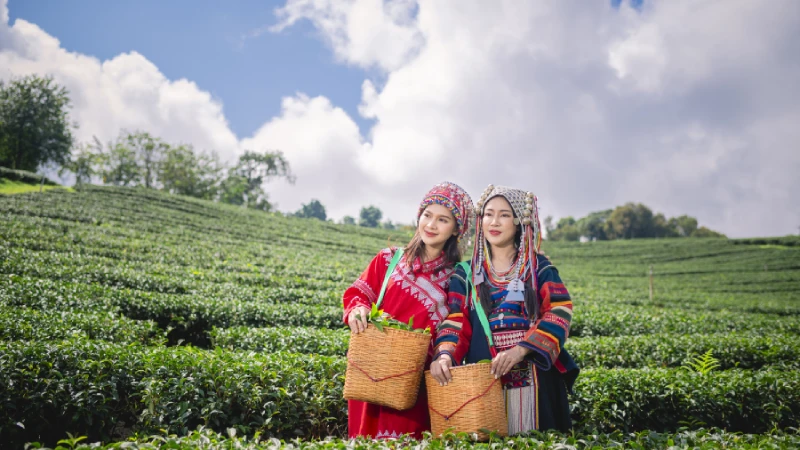Introduction
Darjeeling, famous for its serene landscapes and aromatic tea, is also home to a rich tradition of weaving and textiles. Passed down through generations, the art of weaving in Darjeeling reflects the unique cultural blend of the Himalayan and Tibetan influences. From intricately designed woolen shawls to vibrant handwoven fabrics, these textiles embody the spirit and heritage of this hill station. This guide delves into the traditional weaving practices and textiles of Darjeeling, showcasing their craftsmanship and cultural significance.
1. Woolen Shawls and Stoles
Highlights
- What It Is: Handwoven shawls and stoles made from yak wool, sheep wool, and sometimes Pashmina.
- Cultural Significance: Essential for the cold Himalayan climate and often adorned with traditional motifs.
- Where to Find: Bhutia Market, Chowrasta, and local artisan shops.
Fun Fact
These shawls often feature patterns inspired by nature, such as flowers, mountains, and rivers.
2. Lepcha Weaving
Highlights
- What It Is: A traditional art form practiced by the Lepcha community, known for their vibrant and intricate handwoven fabrics.
- Cultural Significance: The Lepcha fabrics often hold symbolic meanings and are used in ceremonies and rituals.
- Where to Find: Specialized workshops and local markets.
Pro Tip
Look for Lepcha scarves and traditional dresses, which are popular souvenirs.
3. Tibetan Rugs and Carpets
Highlights
- What It Is: Beautifully crafted carpets with Tibetan motifs, often made using traditional hand-knotting techniques.
- Cultural Significance: Carpets are a staple in Tibetan households, symbolizing warmth and heritage.
- Where to Find: Tibetan Refugee Self Help Centre and artisan workshops.
Fun Fact
Each carpet can take weeks to months to complete, depending on its size and complexity.
4. Handwoven Woolen Fabrics
Highlights
- What It Is: Durable and warm woolen fabrics used to make coats, jackets, and blankets.
- Cultural Significance: Often woven by local women, showcasing their artistry and connection to nature.
- Where to Find: Bhutia Busty and nearby villages.
Pro Tip
Custom-made woolen garments are a great way to support local artisans while taking home a unique piece.
5. Himalayan Textiles
Highlights
- What It Is: Textiles made using natural fibers such as hemp, nettle, and cotton, dyed with natural colors.
- Cultural Significance: Reflects sustainable practices and the use of natural resources from the Himalayan region.
- Where to Find: Kalimpong and local craft fairs.
Fun Fact
The use of plant-based dyes gives these textiles a unique and earthy color palette.
6. Traditional Tibetan Dresses
Highlights
- What It Is: Handwoven garments such as Chuba (traditional Tibetan attire), often made from wool or silk blends.
- Cultural Significance: Worn during festivals and special occasions, showcasing Tibetan heritage.
- Where to Find: Tibetan markets and cultural centers.
Pro Tip
Ask about the stories behind the patterns, as many designs have symbolic meanings.
7. Weaving Techniques and Tools
Highlights
- What It Is: Traditional weaving techniques involve the use of backstrap looms and handlooms.
- Cultural Significance: These techniques have been passed down through generations and require immense skill.
- Where to Learn: Workshops at the Tibetan Refugee Self Help Centre.
Fun Fact
The rhythmic sound of the loom is often considered therapeutic by local weavers.
8. Sustainable Practices in Weaving
Highlights
- What It Is: Many weaving communities focus on eco-friendly practices, using natural fibers and dyes.
- Cultural Significance: Promotes a sustainable lifestyle and supports the local ecosystem.
- Where to Find: Markets and craft stores promoting sustainable products.
Pro Tip
Look for certifications or inquire about the eco-friendly nature of the textiles before purchasing.
9. Festivals and Exhibitions
Highlights
- What It Is: Annual festivals and craft fairs showcasing Darjeeling’s traditional weaving and textiles.
- Cultural Significance: Provides a platform for artisans to display their skills and sell their creations.
- Where to Experience: Darjeeling Handicraft Fair and Himalayan festivals.
Fun Fact
Many fairs feature live weaving demonstrations, giving visitors a glimpse into the art form.
10. Supporting Local Weavers
Highlights
- What It Is: Buying directly from weavers and artisan collectives helps sustain the local economy.
- Cultural Significance: Encourages the preservation of traditional weaving practices.
- Where to Buy: Tibetan Refugee Self Help Centre, Bhutia Market, and local cooperatives.
Pro Tip
Always ask about the origin of the textile to ensure its authenticity and support the artisans.
Conclusion
The traditional weaving and textiles of Darjeeling are more than just functional; they’re a reflection of the region’s cultural identity and artistic brilliance. By exploring and supporting this heritage, you not only take home a piece of Darjeeling’s soul but also contribute to the preservation of these timeless crafts. So, on your next visit, immerse yourself in the vibrant world of Darjeeling’s textiles and discover the stories they tell.
FAQs
Where can I buy authentic textiles in Darjeeling?
Bhutia Market, Tibetan Refugee Self Help Centre, and artisan workshops are the best places to find authentic textiles.
Are Darjeeling’s textiles eco-friendly?
Yes, many textiles are made using sustainable practices, including natural fibers and dyes.
What makes Lepcha weaving unique?
Lepcha weaving is known for its vibrant colors, intricate patterns, and cultural significance.
Can I watch weaving demonstrations in Darjeeling?
Yes, workshops and craft fairs often feature live weaving demonstrations.
What is the price range for traditional textiles in Darjeeling?
Prices vary based on the material and craftsmanship, ranging from affordable to premium.

